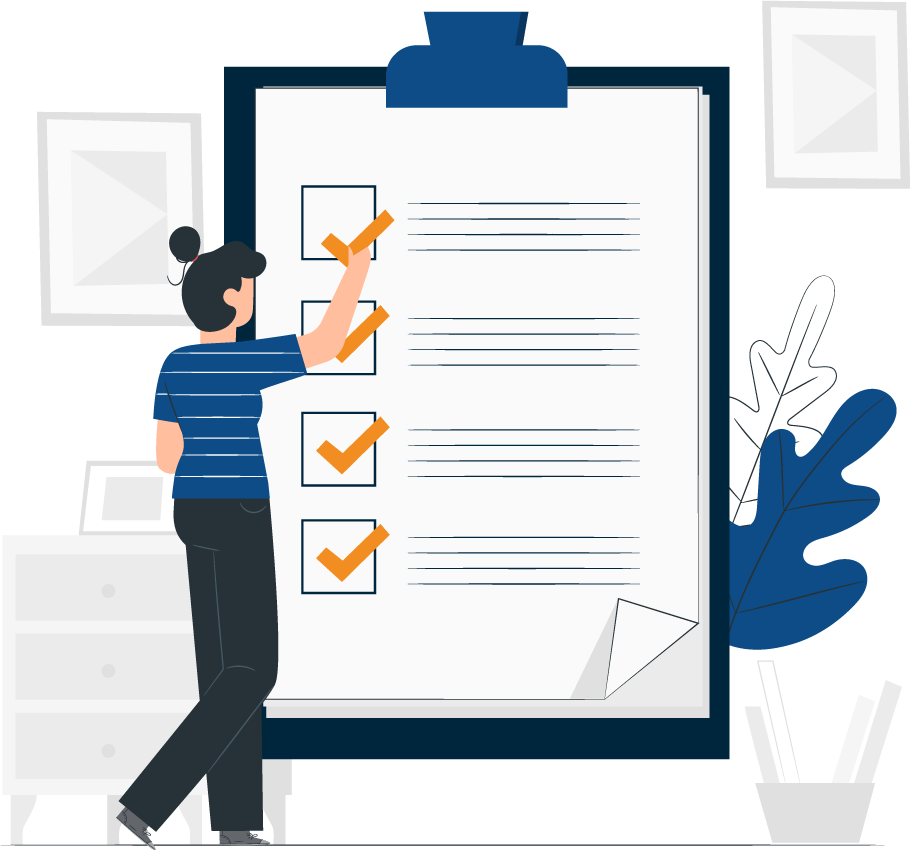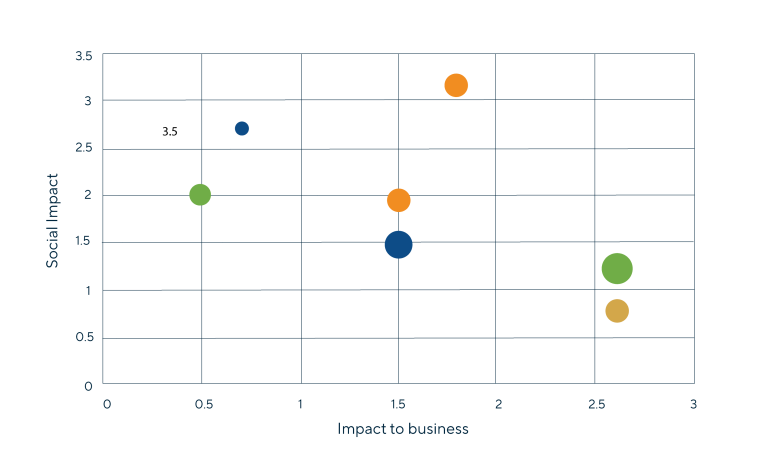Curious how to start with ESG reporting? An ESG materiality assessment is a template that helps identify and prioritize ESG topics that are of key importance to your organization. It is a step by step plan in stakeholder engagement and identification of important specific ESG (Environmental, Social and Governance) topics to your organization. A number of esg reporting frameworks that exist in the ESG space can be useful in aligning your strategies with various aspects, such as your portfolio composition, overall ESG objectives, investor, or stakeholder demands.
The steps of materiality assessments include:
Research
1.1 Goals & Vision
1.2 Identify stakeholders
1.3 Benchmark results against peers and competitors
1.4 ESG issuesEngage
Prioritize
Communicate Results
a. Putting your research into action
b. Assuring the success of your new ESG initiatives
1. Research
1.1 Goals and Vision

This step is meant to determine what sustainability and ESG efforts mean to your organization. Knowing the mindset of your employees will help guide your strategy in encouraging engagement. Understanding the mindset of your team members will help you determine the amount of encouragement needed to drive engagement during this initiative, and give you an idea of the end results you’ll be able to achieve.
- Define success; what are your performance based targets?
- Evaluate your long-term strategy
- Decide on ESG framework

1.2 Identifying Stakeholders

It is important to thoroughly identify a wide range of stakeholders while performing a materiality assessment. Stakeholders encompass a variety of constituents with a direct or indirect involvement in the organization, including customers, suppliers, employees, creditors, trade unions, local communities, and local governments. Collectively, these stakeholders have a vested interest in the success of the organization and will be impacted by any decisions or changes made.
A comprehensive materiality assessment should include an analysis of all these stakeholders, their wants and needs, and any potential risks or opportunities associated with them. An effective assessment should also consider their level of influence, the degree to which their interests align with those of the organization, and the potential for collaboration and partnership. By identifying and engaging with stakeholders in the materiality assessment process, organizations can ensure that the resulting strategy is well-informed, practical, and beneficial to all involved.
The list of stakeholders can expand into local communities an NGO, industry trade groups, and more. Decent identification of stakeholders gives you a comprehensive understanding of the potential implications of any material change.
The more stakeholders you talk to during your research phase, the better your understanding of the situation will be. Each group of stakeholders will provide new perspectives and insights that you may not have considered if you only interviewed a limited number of people.
1.3 Benchmark results against peers and competitors
Discover what your peers are prioritizing and disclosing. Frameworks they might be using include the SASB standards, GRI standards and the UN’s sustainability goals. Include these findings in your assessment.
1.4 ESG Issues
List down all the topics you have uncovered and map them under the three pillars: Environmental, Social and Governance.
An overview of topics can be found here.
Environmental Pillar
- Carbon emissions
- Product carbon footprint
- Financing environmental impact
- Climate change vulnerability
- Water stress
- Biodiversity & land use
- Raw material sourcing
- Toxic emissions & waste
- Packaging materials & waste
- Electronic waste
- Opportunities in clean tech
- Opportunities in green building
- Opportunities in renewable energy,
Social Pillar
- Labor standards
- Health and safety
- Human capital development
- Supply chain labor standards
- Product safety and quality
- Chemical safety
- Privacy and data security
- Responsible investment
- Ensuring health and demographic risk
- Controversial sourcing
- Access to communication
- Access to finance
- Access to healthcare
- Opportunities in nutrition and health
Governance
- Board diversity
- Pay
- Ownership
- Accounting
- Business ethics
- Anti competitive practices
- Corruption
- Financial system instability
- Tax transparency
2. Engage
2.1 Engage with Stakeholders
List down all the topics you have uncovered and map them under the three pillars: EnEffective stakeholder outreach is a key part of a successful ESG assessment. Without it a project can be delayed or canceled. Stakeholders must feel valued and be taken seriously.
Survey your key stakeholders to get feedback on the most important issues your company is facing. Refine your findings based on their input. Interviews should also be used for mining qualitative insights and ESG information.
3. Prioritize Topics

Use the data to identify trends and prioritize topics for your organization.
The number of ESG reporting frameworks in the ESG landscape can be a useful tool to ensure that your company’s strategies are in line with the sustainability goals that you have set.
In order to determine which framework to align with, it is important to consider the makeup of your portfolio, the overall ESG objectives that you are aiming to achieve, and the demands from your investors and stakeholders.
Once the appropriate framework has been identified, be sure to review the reporting requirements and any necessary adjustments that need to be made to ensure full compliance. Additionally, it is important to stay up-to-date with any changes to the framework and industry best practices, as this will help to ensure that your ESG reporting is accurate and effective.

3.1 Methodology
During this part you will determine how you will quantify and summarize the results of your research across the organization and channels. An accurate picture is gained by scoring each topic according to how well it meets the priority criteria and weighting each factor according to its importance to the organization.
Score on importance to the business, society and based on what’s trending in the industry.
3.2 Scoreboards
After creating your scoring methodology all topics will end up on a materiality matrix scoring board with their respective numbers giving you a clear overview of the key topics that should be addressed.
3.3 Double Materiality
Companies have to report about how sustainability issues affect their business and about their own impact on people and the environment. In this step you map the intersections of topics that are financially material and which ones are environmentally and social.

4. Communicate Findings
Share your research results with leaders and determine the appropriate action items.
Information that is typically shared:
- ESG position and vision
- Business risks in case goals are not met
- A roadmap for the specific ESG Goals: planning, reporting & analytics.
- List of deliverables which could include: ESG mini site, reports or disclosures
Assuring the success of ESG Initiatives
The materiality assessment is just the first step in your ESG journey. After key topics are chosen and improvement programs have been initiated its key to track progress and communicate results to the stakeholders.
But rolling out your reporting and ESG strategy is challenging. It includes a lot of manual work from collecting ESG data from many different sources to analysis and reporting. Many organizations still manage ESG reporting via Excel or multiple tools, but both of these approaches create a data collection, consolidation and reporting process that’s separate from financial reporting.

AMCO’s ESG tool will allow you to automate the reporting of your environmental, social, and governance (ESG) initiatives alongside your financial metrics and process them as financial data. This alignment will eliminate duplication, increase accuracy, ensure compliance, and improve the overall success of ESG initiatives.
Request a Demo
Ready to take the next step? Book a meeting with our experts or fill up the
contact form to know more about how we can help you in your finance journey.
Request a Demo
Ready to take the next step? Book a meeting with our experts or fill up the contact form to know more about how we can help you in your finance journey.
Related Resources

The Definitive Guide to ESG Reporting
This guide will cover all the important questions around ESG reporting. If you want to improve your ESG score and guarantee the success of ESG initiatives, this guide is for you.

How businesses can ensure reduction in expenditure and drive growth with Zero-Based Budgeting
Discover a wealth of information from our experts on financial reporting, ESG, lease accounting and more.

Get to know AMCO
With over 100+ OneStream customers for 175+ projects to date globally. AMCO Solutions offers full lifecycle: implementation, training development, and managed services.


